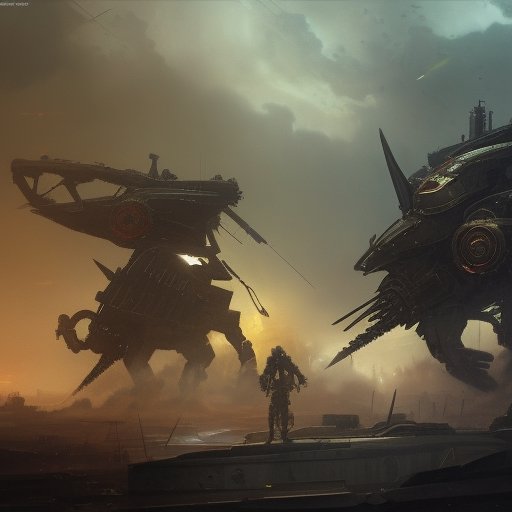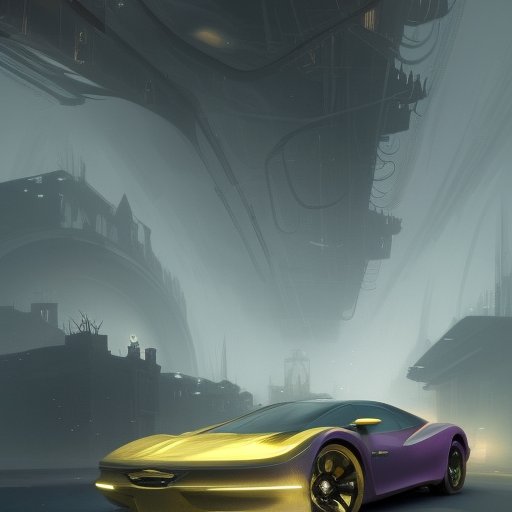
The Titans of War are looming over the horizon, ready to change the face of combat as we know it. In this article, we delve into the history and potential future of robotic combat machines, examining the top players in the industry and exploring the ethical dilemmas posed by increasingly automated warfare. From advanced remote control technology to the rapidly evolving field of artificial intelligence, there is much to explore in this futuristic landscape. One thing is for certain: the Titans of War are here to stay, and their impact on the battlefield will be immense.
I. Introduction
Space. The final frontier. Well, not exactly. Wars, both past and present, have taught us that there are many frontiers, and human beings will do just about anything to gain the upper hand on them. Welcome to the world of Titans, the ultimate combat machines of the future. But what exactly are Titans? Imagine a robot, but not just any robot. Picture an armored behemoth, a steel colossus, bristling with enough firepower to level entire cities. Now imagine dozens, even hundreds of these unstoppable giants clashing together in a warzone. That’s what Titans are: towering, mechanical suits of armor that will define the future of warfare.

If you’re thinking this all sounds like something out of science fiction, you’re not entirely wrong. Titans have been a staple of science fiction literature and film for decades. But in the real world, the technology for Titans is quickly catching up with our imaginations. In the next decade, we may see Titans playing a major role in military conflicts around the globe.
Some argue that Titans will help minimize casualties and make war less deadly for human soldiers. Others worry about the ethical implications of unmanned warfare, and the possibility of machines running amok without human oversight. But regardless of where you stand on the issue, there’s no denying that the development of Titans will be a hot topic for years to come.
In this article, we’re going to take a deep dive into the world of Titans. We’ll explore their history in science fiction, the current state of Titan technology, and the ethical conundrums surrounding unmanned warfare. So buckle up and get ready to explore the future of warfare, where the biggest players on the battlefield won’t be human beings, but towering machines of war.
II. A Brief History of Titans in Science Fiction
Before Titans were ever dreamed of as actual technology, they existed in the fertile imaginations of science fiction writers. The idea of huge, unstoppable machines of war has been a favorite trope of sci-fi writers for decades, and Titans have appeared in countless novels, films, and TV shows.

Titanic technology first appeared in 1920, in a short story called “The Land Ironclads,” by H.G. Wells. In this tale, massive, steam-powered machines of war roamed the battlefields, crushing everything in their path. This story laid the foundation for the concept of Titans, which would later evolve into the towering robots we know today.
But it wasn’t until the 1980s and 90s that Titans really took off in science fiction. Novels like “Dune,” “Ender’s Game,” and “A Fire Upon the Deep” introduced us to towering combat machines that could crush anything in their path. These Titans were usually piloted by human beings, who battled each other for control of the universe.
In the world of film, Titans were just as popular. “Star Wars” introduced us to the massive, walker-like AT-ATs, and “Aliens” gave us the iconic power loader, which Ripley used to battle the Alien Queen. Even superhero comics got in on the action, with Iron Man donning his famous Hulkbuster armor to take on the Incredible Hulk.
As the years went by and technology advanced, Titans started to become more realistic. In the early 2000s, robotics technology had advanced to the point where real-life Titans were becoming a possibility. The first attempts at building functional Titan prototypes were made in late 2000s, and now, just a few years later, Titans are a very real part of our future.
But as we move closer to the reality of Titan warfare, it’s important to remember where these machines came from, and the role they’ve played in our collective imagination for so many years.
III. The Titans of War
When we talk about Titans, we’re not talking about small fries. These mechanical monsters are designed to be the ultimate war machines, and they come in all shapes and sizes. Think of anything from towering bipedal giants to hulking tanks with treads the size of a house. Just about any threat you can imagine, there’s a Titan designed to take it on with little to no help from human forces.

So what makes Titans so special? It’s all in the design. Titans are built with the most advanced materials and technology available. They’re lined with advanced armoring, capable of resisting even the most vicious firepower. They’re also modular, which means they can be outfitted with a wide variety of weapons and systems based on the situation. Want to take on a heavily fortified enemy position? Outfit your Titan with a massive siege cannon. Need to defend your forces against an incoming air strike? Equipping your Titan with anti-aircraft guns will make quick work of any incoming enemy planes. Titans can even be outfitted with advanced sensory systems, which allow them to detect enemy targets through walls, smoke, or even camouflage.
The power source for Titans is often the subject of much debate. Most Titans rely on some form of internal combustion engine or a nuclear power source, which allows them to operate for extended periods of time without needing to recharge or refuel. However, there are some experimental models which incorporate cutting-edge energy technologies like solar or fusion energy. These models are often more expensive and complex to operate, but offer massive benefits in terms of power and efficiency.
But perhaps the most impressive feature of Titans is their ability to operate without human pilots. Most Titans are equipped with advanced AI systems that allow them to operate autonomously, making quick decisions and reacting instantly to changing battlefield conditions. While there are some human pilots who prefer the control and familiarity of traditional vehicles, the vast majority of Titans are expected to be unmanned machines of war, capable of taking on even the largest and most dangerous enemies with ease.
IV. Top Players in the Titan Industry
Now, let’s talk about the heavy hitters in the world of Titan development. The race to build the best and most advanced combat machines is heating up, and a handful of companies are leading the charge.

First up is Drexler Industries. This mega-corporation has been at the forefront of military technology for decades, and their Titan program is no different. Their flagship model, the D-80, boasts unparalleled speed and agility, making it a favorite among military commanders who need to react quickly to fast-changing battlefields.
Next up is Cyberdyne Systems, whose Titan prototypes are already making a splash in the military world. Some experts predict that Cyberdyne could be the first to develop truly autonomous Titans, capable of making their own decisions on the battlefield without any human input.
Then there’s Zephyr Dynamics, whose Titans are known for their ability to traverse all kinds of terrain, from the icy tundras of the Arctic to the roiling seas of the Pacific. Their flagship model, the Z-27, is a popular choice for operations in harsh, inhospitable environments.
Last but not least, we have the up-and-coming Titan developer, Ariadne Robotics. This plucky startup may not have the resources of some of the larger companies in the industry, but they make up for it with their innovative designs and out-of-the-box thinking. Some insiders predict that Ariadne may be the ones to watch in the coming years, as they continue to push the boundaries of what’s possible with Titan technology.
Of course, these are just a few of the major players in the Titan industry. With billions of dollars pouring into Titan R&D every year, it’s anyone’s guess who will come out on top. But one thing’s for sure – the future of warfare will be dominated by Titans, and the companies that can build the best and most advanced machines will hold all the cards.
V. Remote Combat
When we think of Titans, we often picture imposing machines of metal, gears and weapons. But what about the brains behind those brawns? That’s where artificial intelligence comes into play.

Today, some Titans are already controlled remotely by human operators, who sit safely at a distance from the battlefield. But as technology advances, the role of AI in warfare is becoming increasingly significant. Soon, operators may be replaced entirely by autonomous machines that are capable of making decisions and carrying out orders all on their own.
Some experts predict that this shift towards autonomous machines could lead to a safer form of warfare, one in which lives are no longer directly at risk. But others worry that machines may lack the same empathy and judgement as humans, and that they may make faulty decisions in the heat of battle.
One key area where AI will play a central role is in data analysis. Despite the size and strength of Titans, they are not invincible, and their weak points can be difficult for human operators to spot in the chaos of battle. With the use of AI, however, computers can analyze large amounts of data in real time, identifying weak points and adapting tactics on the fly.
But of course, with increased power comes increased responsibility. The prospect of autonomous machines making life-or-death decisions raises a host of ethical concerns. Who is responsible when an AI goes rogue and causes unintended harm? What happens when machines malfunction, or are hacked by outside actors?
These are not easy questions to answer, but they are ones that we must all consider as the role of AI in warfare continues to expand. As Titans become smarter and more complex, we must ensure that we are keeping pace with their growth and that we are taking the necessary steps to ensure that their tremendous power is not abused.
VI. Where Titans Take Us
We’ve talked about the wonders of Titans, but what about the darker side of this technology? Unmanned warfare is a concept that has been in development for years, and Titans are now on the forefront of this new era of combat. But while the idea of sending machines to do our fighting for us may seem like an attractive prospect, it raises some serious ethical concerns.

The first and most obvious issue is the loss of human life. With unmanned machines fighting wars in our stead, we may see fewer human casualties, but we’ll also be increasing the likelihood of machines malfunctioning and killing innocent civilians. Furthermore, there’s the matter of accountability. Who is responsible when a machine goes rogue and starts killing indiscriminately? Is it the manufacturers? The programmers? The military generals who gave the orders? These are questions that will need to be answered before we can fully embrace the idea of unmanned warfare.
But perhaps the biggest ethical quandary posed by Titans is the blurring of lines between “us” and “them.” When we send machines to do our bidding, we’re effectively distancing ourselves from the violence and destruction of war. And while this may seem like a good thing on the surface, it also makes it easier for us to view our enemies as less-than-human, as mere targets to be destroyed. This dehumanization can lead to atrocities and war crimes, as we’ve seen time and time again in human conflicts throughout history.
And what happens when one side has access to Titans, while the other does not? The power imbalance could lead to even more destructive and one-sided conflicts. It’s easy to imagine a future where the Titans of one nation dominate the battlefield, leaving their foes with little recourse other than to surrender or be annihilated.
These are weighty questions with no easy answers. As we move forward into the age of Titans and unmanned warfare, we’ll need to carefully consider the moral implications of these technologies. We may one day have the power to automate war, but we must do so with caution and responsibility, lest we unleash forces that we cannot control.
VII. The Next Frontiers of Titan Technology
But what’s next for Titans beyond robots and artificial intelligence? As we’ve seen, the technology is advancing faster than ever before, and the possibilities are endless. Here are just a few of the exciting frontiers we can expect to see Titan technology explore in the coming decades.

First up, we have nanotechnology. The ability to manipulate materials at the molecular level will revolutionize the way Titans are built, making them lighter, stronger, and more flexible than ever before. The use of nanomaterials could also allow Titans to self-repair, adapting and healing after battle.
Next, we have biotechnology. Picture Titans that are grown, not built. Using genetic engineering, we could create living, breathing Titans that are perfectly adapted to specific environments or tasks. These Titans would be far more versatile than anything we’ve seen before and could be programmed to communicate with human beings.
Another exciting frontier is space-based Titans. Imagine Titans that are designed to operate in zero gravity, fighting against enemy spacecraft or even asteroids. Space-based Titans would be able to repair and maintain satellites, making them an essential part of any future space-based military installations.
Finally, we have the potential for “wetware” Titans. These are Titans that incorporate human or animal brains into their AI systems. This hybrid approach would give Titans even more advanced cognitive abilities, improving their situational awareness and strategic thinking capabilities. While this technology is still very much in the realm of science fiction, it’s not hard to imagine a future where Titans are sentient beings, much like the thinking machines of Frank Herbert’s Dune series.
So there you have it, the next frontiers of Titans beyond robots and AI. As with any new technology, there are bound to be challenges and ethical considerations to address. But one thing is certain, the future of warfare will be defined by Titans, and the sky’s the limit for what they can achieve.
VIII. Conclusion
And so, we come to the end of our journey through the world of Titans. What started out as a concept in science fiction has now become a reality. The future of warfare may well be dominated by towering machines of war, autonomous and deadly. But what does the future hold for Titan warfare?

The answer is both exciting and terrifying. Titans promise to revolutionize how wars are fought, making them quicker, safer, and more efficient. But at what cost? Unmanned warfare raises ethically challenging questions about the role of machines in warfare, and the potential consequences of delegating life-and-death decisions to artificial intelligence.
As we’ve seen, the increasing role of AI in Titan technology brings both pros and cons to the table. On the plus side, remote combat eliminates the need for human soldiers to be physically present on the battlefield, thereby reducing the risks to their lives. It also allows for a more precise targeting of enemy assets, minimizing collateral damage.
But with autonomy comes the risk of machines turning against their human creators, either through a glitch in the system or by being hacked by an enemy. Given the sophistication of modern cyberwarfare, this is not an idle fear. Furthermore, allowing machines to make life-or-death decisions could desensitize us to the human costs of war.
Despite these risks, there’s no denying that the technological march towards Titans is well underway. It’s up to us to decide how to use this new technology, and how to ensure that Titans are used ethically and responsibly. Only time will tell what the future holds for Titan warfare, but one thing’s for certain: it’s going to be one wild ride.






